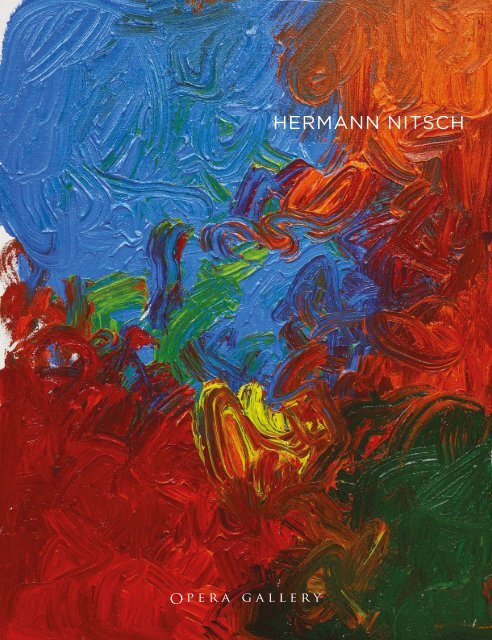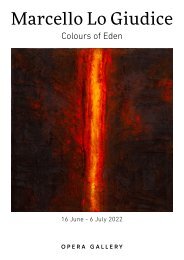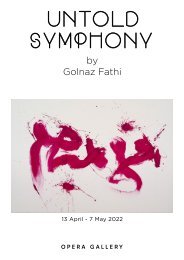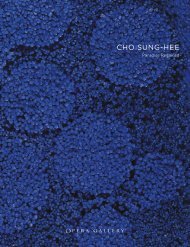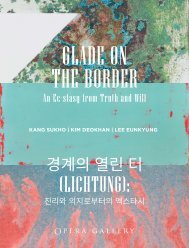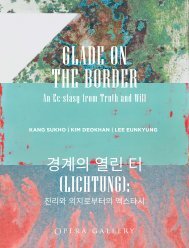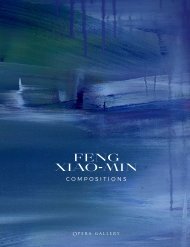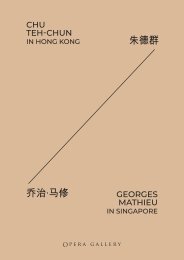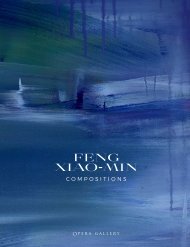Hermann Nitsch | Opera Gallery London | 14 Oct. - 14 Nov. 2021
You also want an ePaper? Increase the reach of your titles
YUMPU automatically turns print PDFs into web optimized ePapers that Google loves.
HERMANN NITSCH
HERMANN NITSCH
<strong>Hermann</strong> <strong>Nitsch</strong>, 40 th Painting Action, Museum of the 20 th Century (now: Belvedere 21), Vienna, 1997 © <strong>Hermann</strong> <strong>Nitsch</strong>, photo by Heinz Cibulka
FOREWORD<br />
<strong>Opera</strong> <strong>Gallery</strong> <strong>London</strong> is pleased to present a solo exhibition featuring recent paintings as well as<br />
historic works by Austrian artist <strong>Hermann</strong> <strong>Nitsch</strong>.<br />
Considered a key figure in Viennese Actionism of the 1960s, <strong>Hermann</strong> <strong>Nitsch</strong> continues to use a<br />
radical method of painting, essentially through his creation of the Orgien Mysterien Theatre, a concept<br />
of ceremonial performance art comparable to Wagner’s Gesamtkunstwerk (total art work). This<br />
total art form calls to all five human senses and advocates for a profound existentialist reflection.<br />
<strong>Hermann</strong> <strong>Nitsch</strong> creates his paintings using his entire body. Therefore, they are simultaneously<br />
the origin and the result of his performances. Using or applying oil or acrylic paint of a certain<br />
hue, he spreads it on canvas using unconventional tools as well as his hands, feet and whole body<br />
movements. Through these actions, <strong>Nitsch</strong> demonstrates his energetic, spiritual, sensual and<br />
passionate persona. Chaos and violence, which accompany his work, are in fact a celebration of<br />
life and mirror the human soul.<br />
His works are exhibited in the two <strong>Nitsch</strong> Museums in Mistelbach and Naples as well as in the <strong>Nitsch</strong><br />
Foundation in Vienna and can be found in the permanent collections of preeminent international<br />
museums and galleries, including: MoMA, Guggenheim, The Metropolitan Museum New York, Tate<br />
<strong>Gallery</strong> <strong>London</strong>, The Centre Pompidou Paris, Pinakothek der Moderne Munich and many more.<br />
Gilles Dyan<br />
Founder and Chairman<br />
<strong>Opera</strong> <strong>Gallery</strong> Group<br />
Federica Beretta<br />
Director<br />
<strong>Opera</strong> <strong>Gallery</strong> <strong>London</strong><br />
5
HERMANN NITSCH BY<br />
BÉNÉDICTE MASELLI<br />
Born in 1938 in Vienna, Austria, <strong>Hermann</strong> <strong>Nitsch</strong><br />
is a member of one of the most radical art<br />
movements of the 1960’s: Viennese Actionism.<br />
Austria, in the aftermath of the fall of the<br />
Habsburg Empire, and following WWII and<br />
the expulsion or extermination of its Jewish<br />
population and intellectual elite, had seen the<br />
movements initiated by various artists and<br />
thinkers spearheading Viennese modernity<br />
at the end of the 19 th and the beginning of the<br />
20 th centuries come to a sudden halt. Indeed, at<br />
the end of the conflict, the advances exemplified<br />
by Egon Schiele’s and Oskar Kokoschka’s<br />
expressionism, Sigmund Freud’s psychoanalysis,<br />
Gustav Mahler, Arnold Schönberg and Alban<br />
Berg’s musical innovations, Robert Musil’s and<br />
Georg Trakl’s literary exploration, as well as the<br />
philosophy of the Vienna Circle including Ludwig<br />
Wittgenstein, had been abruptly interrupted by<br />
the death and/or the exile of their leading figures.<br />
Post-war Austria’s socio-political ambiguousness<br />
and the latent nature of the Austrian people’s<br />
guilt, whether reckoned or repressed, didn’t<br />
allow for – in the image of the other European<br />
countries – a post-war renaissance heralding<br />
a new world. Thus, deprived of the avant-garde<br />
impetus such as occurred in other European<br />
countries, Austria was confronted with an<br />
artistic paralysis between what had begun<br />
taking shape prior to the war and the newly<br />
established positions of the Wiener Gruppe.<br />
A movement originating in Vienna’s literary cafés<br />
in 1958, Viennese Actionism, although quite<br />
eclectic with respect to the themes they broached,<br />
produced a highly radical art language inspired<br />
by literature and psychoanalysis, criticizing the<br />
nation’s artistic and intellectual stagnation, which<br />
they saw as dangerous and immoral.<br />
It was in this context that <strong>Hermann</strong> <strong>Nitsch</strong> began<br />
his actionist pictorial production, in an approach<br />
that was as original as it was universal since<br />
he broke away from the mainly political stance<br />
encompassed by Viennese Actionism to instead<br />
turn to existentialism and the spiritual dimension<br />
it entails.<br />
However, it is important to understand the<br />
significance that painting holds in <strong>Hermann</strong><br />
<strong>Nitsch</strong>’s work, as he is an artist first and foremost<br />
associated with historical performance. This<br />
said, he never renounced pictorial creation,<br />
as it is an integral part of his body of work,<br />
the Theatre of Orgies and Mysteries, which is<br />
commonly referred to as OM Theatre, after its<br />
German name, the Orgien Mysterien Theater. It is<br />
important to note that the artist first developed<br />
this concept through writings at the age of 19, in<br />
1957, before having yet determined its language<br />
and plastic expression. It therefore preceded<br />
Viennese Actionism.<br />
<strong>Hermann</strong> <strong>Nitsch</strong>’s creative expression is rich and<br />
proteiform, calling upon numerous media such<br />
as painting and action as well as installations,<br />
opera, musical creation, drawing, and engraving,<br />
which are all constitutive of the Theater, otherwise<br />
meant as a total work of art in accordance with<br />
the Wagnerian concept of Gesamtkunstwerk.<br />
It is very important to understand the following:<br />
when you are contemplating one of <strong>Nitsch</strong>’s<br />
paintings, it is actually the Theater that you are<br />
gazing at and touching upon.<br />
7
Establishing an original pictorial practice<br />
As of 1952, and for the five years that followed,<br />
<strong>Nitsch</strong> took private art classes with the reactionary<br />
sculptor Karl Nieschlag, who’d rejected Modernism<br />
outright and mainly produced religious art. It was<br />
through his work with him that <strong>Nitsch</strong> decided,<br />
at the age of 15, to become a church painter.<br />
Thus he drew his inspiration, among other<br />
sources, from Renaissance and Baroque art,<br />
very present in Austria thanks to the reign of<br />
the Habsburgs. The theme of the crucifixion,<br />
in particular, retained his attention and never<br />
left his iconography, as attested to by some<br />
of his earliest works, in which he’d copied<br />
crucifixions by El Greco, Titian, Rembrandt,<br />
and Matthias Grünewald, to name a few.<br />
The presence of the Christic figure in the<br />
latter’s work had a significant impact on<br />
<strong>Nitsch</strong> and he repeatedly referred to it in<br />
his theoretical writings relating to colour<br />
seen as a manifestation of the sacred.<br />
The image of Christ on the cross, as we<br />
will see, is of particular interest to him<br />
because it ontologically holds the idea of the<br />
prophecised resurrection.<br />
Moreover, in 1959, he attended the Junge Maler der<br />
Gegenwart exhibition at the Vienna Künstlerhaus,<br />
in which works from the Informelism and<br />
American Abstract Expressionism movements<br />
were presented. These included works by<br />
Georges Mathieu and Jackson Pollock, about<br />
which <strong>Nitsch</strong> said:<br />
“i saw works by mathieu and the americans and<br />
told myself: what these painters are doing is akin<br />
to what i’m doing with theatre. i mustered my<br />
courage and started painting, meaning that i gave<br />
concrete expression on the surface of a painting<br />
to the ideas i’d had for my theatre, spilling red<br />
paint onto canvas, organizing an actionist form<br />
of painting spilling thin or thick painting on the<br />
floor of entire rooms.”<br />
Discovering French as well as American action<br />
painting was a decisive spark for <strong>Nitsch</strong> as it<br />
embodied through its very gesture and the frantic<br />
action of painting itself what he ambitioned to<br />
achieve with his Theater all along: a release,<br />
a therapeutic form of art which represented<br />
a prefiguration of what the 1998 performance<br />
of his 100 th Action, the full staging of the<br />
Sechs Tage Spiel (six-day-play), accomplished.<br />
It was thus the concomitant discovery of mystical<br />
themes as well as the in-depth exploration of their<br />
symbolic significance – through psychoanalysis<br />
in particular – and the confrontation with radical<br />
Viennese informal art and action painting – by<br />
the likes of Mathieu and Pollock – that enabled<br />
him to establish a language and formal plastic<br />
expression of his own.<br />
In fact, it was the importance of the gesture<br />
itself that <strong>Nitsch</strong> retained and which he<br />
started experimenting with in <strong>Nov</strong>ember<br />
1960 with his first Malaktion (the contraction<br />
of the German terms for painting, malerei,<br />
and action, aktion), meaning action painting,<br />
at the Technisches Museum in Vienna.<br />
Henceforth, <strong>Hermann</strong> <strong>Nitsch</strong> placed the body<br />
in action at the heart of his pictorial work, the<br />
purpose of the body being to systematically serve<br />
rituals that were consistent with the conceptual<br />
process of the Theater. Indeed, each of his paint<br />
actions followed a somewhat constant and<br />
repetitive process in which three key elements<br />
would, as in Malaktion number 4, be repeated:<br />
the use of red pigment, the implicit or explicit<br />
presence of crucifixion imagery, and the use of<br />
the white frock.<br />
From then on, the artist’s paintings were all<br />
presented in the same way, all taking on two<br />
main forms: large canvasses that he respectively<br />
named either Rinnbild (painting on which<br />
the paint runs on the canvas) or Schüttbild<br />
Kunsthaus, Mürzzuschlag<br />
9.19.1995<br />
Photo: Atelier <strong>Nitsch</strong><br />
Photographer: Matthias Herrmann<br />
8 9
An existentialist painting that<br />
celebrates life<br />
(painting on which the paint is projected onto<br />
the canvas).<br />
He works with brushes and sponges, as well<br />
as directly with his hands and feet, or even<br />
the entire surface of his body. The elements<br />
are soaked in red paint – other colours came<br />
in later in his work – which he rubs, squeezes<br />
and violently squirts, leaving their trace on<br />
the canvas and cultivating a physical, indeed<br />
carnal and sensual rapport with the materials.<br />
This intimate, physical interaction with the<br />
canvas, beyond its obvious intensity, is for the<br />
artist charged with a strong symbolism of its<br />
own, demonstrating the thesis of a ritualised<br />
approach to his artistic practice:<br />
“pouring, spilling, and splattering, squeezing<br />
sponges, slapping paint on, soiling, and rolling<br />
ought not to be seen as an actionist approach<br />
to wielding materials but rather as a shamanic<br />
ritual in which various actions symbolising birth<br />
and death, killing and expiation, are performed<br />
in a process of self-discovery.”<br />
<strong>Nitsch</strong>’s creative process is therefore deliberately<br />
suffused with a strong ritual charge meant to set<br />
off a broader reflection about the individual and<br />
the ephemeral nature of life.<br />
Malaktion<br />
1983<br />
Schloss Prinzendorf, Prinzendorf<br />
Indeed, the artist’s pictorial work plays with<br />
the tension between the idea of life and death,<br />
embodied by the constant use – still true to this<br />
day – of red pigment, which echoes the symbolism<br />
of blood. As early as 1960, the colour red became<br />
essential for him. It is at once, as he explains, the<br />
colour “of aggression, death and excess, but also<br />
that of the sheer intensity of life. Blood is vital.”<br />
Blood is therefore an ambivalent substance,<br />
a semantic junction, as Julia Kristeva commented:<br />
a “place that is conducive to abjectness, where<br />
death and femininity, murder and procreation,<br />
the end of life and the sheer vitality thereof<br />
converge.” It is upon this very tension that<br />
<strong>Hermann</strong> <strong>Nitsch</strong>’s artistic expression, indeed<br />
language, is constructed.<br />
Through his theatre and his action painting, and<br />
in the image of ancient plays, he intends – he<br />
says – to accomplish a body of work meant to<br />
be therapeutic, cathartic, and an outlet, in that it<br />
is a psychological means to extirpate individual<br />
and collective neuroses, through action that<br />
is purposely intense, vehement and frantic.<br />
Indeed, his work ambitions to bring to the<br />
surface, through excessive sensory confrontation<br />
and rituals, repressed thoughts and desires,<br />
whether collective or individual, and to make<br />
them conscious through the action experienced<br />
in the here and now.<br />
This is the reason why in <strong>Nitsch</strong>’s paintings the<br />
matter is alive and retains the presence of the<br />
body and of the act of pictorial creation. The<br />
gestures can still be seen, as can the traces of<br />
hands, fingers, and feet on the surface of the<br />
canvas. We see, just as much as we perceive,<br />
that something powerful has occurred.<br />
In other words, the idea is to confront oneself<br />
with excess to trigger a positive shock acting<br />
as catharsis. This positive shock, resorting to<br />
10 11
“innate symbolism” in the Freudian sense, must<br />
make individuals aware and conscious of their<br />
taboos, whether individual or collective, because:<br />
“this is happening within the boundaries of art,<br />
which means that what is being brought to the<br />
surface instantly arrives at a conscious level,<br />
quite clearly, through its formal expression”, as<br />
explained by the artist.<br />
Furthermore, rituals as well as the notion of<br />
transitioning from one state to another, play<br />
a central role in the Theater. More specifically, as<br />
far as <strong>Nitsch</strong>’s work is concerned, it is the transition<br />
from the profane to the sacred. Indeed, for <strong>Nitsch</strong><br />
“the creation process and OMT must contribute to<br />
forming a unity with the whole” in order to “put<br />
an end to the distinction between immanence<br />
and transcendence 1 ;” he thus from the outset<br />
anchored his work in an anthropological logic.<br />
<strong>Nitsch</strong> adds that, in contact with Theater, the<br />
individual must awaken and experience the<br />
shock of suddenly being akin to a new-born,<br />
new to the world. We can see here an analogy<br />
with the definition that Kierkegaard gave to the<br />
sacred, meaning the idea according to which the<br />
encounter therewith tears us from our ordinary<br />
condition in order to experience something that<br />
is “wholly other.”<br />
<strong>Hermann</strong> <strong>Nitsch</strong> approaches his work as a great<br />
celebration of life, of the Dasein – the being<br />
there – referring in particular to Hölderlin’s<br />
Hyperion: “being one with everything that lives.”<br />
However, <strong>Nitsch</strong> considers and expresses<br />
this Dasein within what is called a holiness of<br />
transgression, expressing himself through the<br />
Dionysian numinous theorized by Rudolf Otto 2 ,<br />
in particular as transgression, physical arousal,<br />
the exaltation of the self, violence and ecstasy.<br />
Precisely, being capable of “ek-stasis” –<br />
ecstasy – means achieving an experience<br />
consisting in transcending oneself towards<br />
that which is not yet or which no longer is: that<br />
which is absent, wholly other, or a mystery.<br />
And indeed this is the essence of <strong>Nitsch</strong>’s<br />
painting as well as the contemplation thereof.<br />
For what the artist seeks to achieve is giving<br />
the beholders the opportunity to experience<br />
something particular that pushes them to<br />
go beyond the self to encounter that which is<br />
not visible.<br />
1<br />
Interview with <strong>Hermann</strong> <strong>Nitsch</strong>, Das aktionstheater<br />
des <strong>Hermann</strong> <strong>Nitsch</strong> zwischen herkunft und zukunft, DVD,<br />
Edition Kröthenhayn, 2006.<br />
The principle of immanence is a principle according to<br />
which nothing comes to the mind that doesn’t already<br />
exist virtually within, that is to say, something that is<br />
inherent to the individual. Transcendence is that which<br />
exists beyond a realm taken as a reference, that which<br />
is above or of another nature. In other words, something<br />
that is separate from and external to the individual.<br />
2<br />
OTTO R., Le sacré, Paris, Payot, 1969.<br />
Secession, Vienna, 21.02.1987, Photo: Atelier <strong>Nitsch</strong>, Photographer: Heinz Cibulka<br />
12 13
Symbols conveying power and the<br />
vibratory presence of matter<br />
That is the reason why <strong>Nitsch</strong> said that his<br />
“theatre must present the complete history of<br />
consciousness,” adding that he wished to write<br />
a great religious play, in which it is neither the<br />
gods nor the idea of God that would be extolled<br />
but rather existence, being there, the Dasein.<br />
In his painting approach, this is materialised in<br />
particular, as we have seen, through the use of<br />
the colour red as a celebration and exaltation<br />
of life. We can note that while <strong>Nitsch</strong> favoured<br />
a monochromatic as well as a dichromatic<br />
(one colour + black) approach for numerous<br />
years, he now uses polychromy as a manifest<br />
expression of this sheer intensity of life.<br />
Furthermore, the immaculate frock he puts on,<br />
representing the universal embodiment of a form<br />
of asceticism found thereafter in all his paint<br />
actions and performances, also materialises<br />
another way of expressing the Dasein. The<br />
assistants who take part in the Malaktions and<br />
Aktions are also dressed in white clothing, as could<br />
be seen in the latest Bayreuth performances. The<br />
ubiquitousness of this white cloth makes it yet<br />
another constitutive element of <strong>Hermann</strong> <strong>Nitsch</strong>’s<br />
creative process.<br />
But what can it possibly mean?<br />
In many philosophico-mystical rituals, whether<br />
profane or not, it represents the condition of the<br />
neophytes before their symbolic integration into<br />
the group of initiates. In either case, the aspirants<br />
wear the white frock as a sign of humility and<br />
sobriety with which they are ready to face the<br />
spiritual experience they are about to join. Through<br />
the use of this new element, the artist includes<br />
the spectator-actor in the aforementioned life<br />
and death tension. Catherine Detrez explained<br />
that “each item of clothing carries within, woven<br />
into its fabric, an ideal body that hides the real<br />
body.” In other words, clothes are the formal<br />
expression of the social, objectified nature of the<br />
body. However, by choosing to use white cloth,<br />
<strong>Nitsch</strong> bestows neutrality and anonymity upon the<br />
subject, which means that it is not the singled-out<br />
social individual that the artist questions but the<br />
individual as a universal being. Renouncing the<br />
social representation of the body and putting on<br />
the ascetic, white garment, the individual enacts<br />
a symbolic, spiritual death for the purpose of<br />
being reborn, spiritually.<br />
This idea of a symbolic death and rebirth – to<br />
encounter that which is wholly other – is also<br />
found in the artist’s recurrent use of the imagery<br />
of crucifixion. In his early pictorial representations,<br />
crucifixion was implicitly present in the titles of the<br />
Schüttbild and Rinnbild paintings. It is in particular<br />
the case of his 1961 Kreuzwegstation (Station of<br />
the Cross), in which his colour of choice – red – is<br />
also present. Other paintings, such as Kreuzblut<br />
triptychon (Cross Blood Triptych) or Geisselwand<br />
(Flagellation Wall), all refer to scenes from the<br />
Passion of the Christ and more particularly to<br />
that of the crucifixion. As mentioned before, what<br />
the artist essentially retains in the tragic event of<br />
the crucifixion is the element that it also heralds<br />
intrinsically: resurrection – the very same as<br />
referred to earlier when talking about symbolic<br />
death and rebirth.<br />
Furthermore, the white cloth used in the making<br />
of the paintings is often later hung to appear as a<br />
cross over the painting. There is thus a repetition<br />
both of the image and concept within itself –<br />
a painting within the painting – and of the symbolic<br />
meaning conveyed by the motif of the cross.<br />
Finally, we also find the fundamental notion of<br />
rebirth that is so important to <strong>Nitsch</strong> in various<br />
references that he makes to nature’s cycles,<br />
nature being something he has always been very<br />
attached to. Such references, in fact, can clearly<br />
be seen in his more recent paintings.<br />
Prinzedorf Castle<br />
July - September 2005<br />
Photo: Atelier <strong>Nitsch</strong><br />
<strong>14</strong> 15
Let us quote the artist one last time with reference<br />
to this subject:<br />
“theatre is a particularly favourable space for the<br />
advent of energy, an energy which arises from<br />
the subconscious, and deeper even, the energy of<br />
the earth, of nature, which must govern rebirth.<br />
i love bodies and i love all the senses. i do not<br />
believe in the separation between the body and<br />
the mind. in nature, everything reproduces and<br />
blends. there is nothing material that is distinct<br />
from that which is spiritual. it is one and the<br />
same, phenomenal energy. my work is a great<br />
celebration of joy: the joy of being there. my work<br />
loves and celebrates life.” 3<br />
<strong>Nitsch</strong>’s painting, in analogy with nature, appears as<br />
a phenomenal source of energy where the material<br />
and the spiritual blend to determine rebirth.<br />
It is interesting to note that from a scenography<br />
standpoint, in the artist’s exhibitions, large<br />
bunches of peonies are placed on the ground<br />
in front of the paintings. In fact, upon the<br />
occasion of his 100 th Action, <strong>Nitsch</strong> had procured<br />
10,000 roses and peonies. Indeed, peonies are<br />
spring blooms, the season when nature is reborn<br />
par excellence, and are therefore a symbol of<br />
rebirth and regeneration; they are also considered<br />
the queen of flowers in far-eastern cultures.<br />
When contemplating <strong>Hermann</strong> <strong>Nitsch</strong>’s more<br />
recent paintings, we realise that the colour<br />
palette is less rigid, and the formal approach<br />
softer, gentler, indeed less implacable. <strong>Nitsch</strong>’s<br />
painting thus appears more as an ode to nature’s<br />
natural cycles in which mingle – just as they do<br />
in existence to give it its full meaning – life and<br />
death, joy and grief, reason and passion, order and<br />
chaos. And because life, in the image of nature, is<br />
motion, and motion is fuelled by contradictions,<br />
<strong>Nitsch</strong>’s painting relentlessly evokes the idea of<br />
a great celebration of life.<br />
<strong>Hermann</strong> <strong>Nitsch</strong>’s pictorial work is consistent in<br />
its formal language, which is organized around<br />
three entities: the red pigment and its variations,<br />
still by far the most present colour even though<br />
polychromy is now his leading approach; the<br />
white cloth; and the cross and its manifestations.<br />
As we have seen, these elements constitute<br />
the foundation of the artist’s theoretical and<br />
practical language. From painting to Theater, via<br />
actions and performances, they are repeated,<br />
embodied in various forms, and through this<br />
take on the value of a ritual. <strong>Nitsch</strong> thus proposes<br />
a ritualised body of work in which the purpose<br />
of symbolic language is to serve the ritual – and<br />
this language, let us not forget, is meant to “put<br />
an end to the distinction between immanence<br />
and transcendence.” As <strong>Nitsch</strong> sees things, the<br />
modern man is no longer in harmony with his own<br />
constitutive essence. There is a breach between<br />
the matter and the spirit – which is against his<br />
beliefs and aspirations – and therefore an end<br />
to the deeper meaning and significance of our<br />
existence. <strong>Nitsch</strong> therefore invites individuals,<br />
through an aesthetic experience that is as rich<br />
as it is original, to shed the woes and alienating<br />
constraints of our lives, as they are the cause of<br />
the destruction of meaning, in order to access<br />
knowledge through redefining desacralised<br />
symbolic language. Indeed, by redefining<br />
discourse and older traditions through the use<br />
of a contemporary artistic expression, <strong>Hermann</strong><br />
<strong>Nitsch</strong> strives to show modern individuals<br />
that the universe surrounding us, in spite of<br />
its sheer diversity, is a consistent whole which<br />
corresponds to an ever-surviving continuity in<br />
which he partakes.<br />
3<br />
NITSCH H., interview with LUC V., Art à mort, Paris,<br />
Léo Sheer, 2002 [our translation].<br />
16
WORKS
BFGP_31/34_21<br />
<strong>2021</strong><br />
Mixed media on canvas<br />
Diptych: 300 x 400 cm | 118.1 x 157.5 in<br />
20
HF_05_20<br />
2020<br />
Mixed media on canvas<br />
200 x 150 cm | 78.7 x 59.1 in<br />
22
SIII_5_05<br />
2005<br />
Mixed media on canvas<br />
200 x 300 cm | 78.7 x 118.1 in<br />
24
13_13_i<br />
2013<br />
Mixed media on canvas<br />
200 x 300 cm | 78.7 x 118.1 in<br />
26
30_<strong>14</strong><br />
20<strong>14</strong><br />
Mixed media on canvas<br />
200 x 300 cm | 78.7 x 118.1 in<br />
28
HF_02_<strong>14</strong><br />
20<strong>14</strong><br />
Mixed media on canvas<br />
200 x 150 cm | 78.7 x 59.1 in<br />
30
01b_<strong>14</strong><br />
20<strong>14</strong><br />
Mixed media on canvas<br />
200 x 300 cm | 78.7 x 118.1 in<br />
32
HF_05_15<br />
2015<br />
Mixed media on canvas<br />
200 x 150 cm | 78.7 x 59.1 in<br />
34
HF_17_18<br />
2018<br />
Mixed media on canvas<br />
200 x 150 cm | 78.7 x 59.1 in<br />
36
HF_35_18<br />
2018<br />
Mixed media on canvas<br />
200 x 150 cm | 78.7 x 59.1 in<br />
38
HF_24_18<br />
2018<br />
Mixed media on canvas<br />
200 x 150 cm | 78.7 x 59.1 in<br />
40
SF_11_19<br />
2019<br />
Mixed media on canvas<br />
150 x 100 cm | 59.1 x 39.4 in<br />
42
HF_36_20<br />
2020<br />
Mixed media on canvas<br />
200 x 150 cm | 78.7 x 59.1 in<br />
44
HF_25_20<br />
2020<br />
Mixed media on canvas<br />
200 x 150 cm | 78.7 x 59.1 in<br />
46
Sascha_20<br />
2020<br />
Mixed media on canvas<br />
200 x 300 cm | 78.7 x 118.1 in<br />
48
Tamme_20<br />
2020<br />
Mixed media on canvas<br />
200 x 300 cm | 78.7 x 118.1 in<br />
50
THE VALKYRIE,<br />
BAYREUTH FESTIVAL<br />
<strong>2021</strong><br />
<strong>Hermann</strong> <strong>Nitsch</strong> followed the honorable invitation<br />
by the Bayreuth Festival and staged the Valkyrie<br />
with a painting action under the musical direction<br />
of Pietari Inkinen. The performances with<br />
10 assistants directed by <strong>Hermann</strong> <strong>Nitsch</strong> took<br />
place in July and August <strong>2021</strong>.<br />
“because of the corona crisis, bayreuth performs<br />
the valkyrie concertante. the singers will stand<br />
at the edge of the stage like at an oratorio. as<br />
an action artist, i have been invited to stage<br />
an actionistic event during the musical course<br />
of all three acts of the valkyrie. i would like to<br />
realize a painting action. the used poured and<br />
smeared colors of the entire rainbow spectrum<br />
will concur with the colorfulness of wagner’s<br />
music in a positive sense. the painting actions are<br />
preliminary stages of my own orgies mysteries<br />
theater, which i have developed in prinzendorf.<br />
i am especially looking forward to the continuous<br />
flow of luminous paint from top to bottom during<br />
these three acts. the painting processes will be<br />
music. sounds will become colors.”<br />
– <strong>Hermann</strong> <strong>Nitsch</strong>, March <strong>2021</strong><br />
Bayreuth Festival <strong>2021</strong><br />
The Valkyrie<br />
Conductor: Pietari Inkinen<br />
Painter: <strong>Hermann</strong> <strong>Nitsch</strong><br />
Lise Davidsen (Sieglinde)<br />
© Bayreuth Festival / Enrico Nawrath<br />
53
Bayreuth Festival <strong>2021</strong><br />
The Valkyrie<br />
Conductor: Pietari Inkinen<br />
Painter: <strong>Hermann</strong> <strong>Nitsch</strong><br />
Middle image: Christa Mayer (Schwertleite), Marie Henriette Reinhold (Grimgerde), Simone Schröder<br />
(Rossweisse), Nana Dzidziguri (Siegrune), Stephanie Houtzeel (Waltraute), Kelly God (Gerhilde), Brit-<br />
Tone Müllertz (Ortline), Daniela Köhler (Helmwige), Iréne Theorin (Brünnhilde), Lise Davidsen (Sieglinde)<br />
Right image: Klaus Florian Vogt (Siegmund), Lise Davidsen (Sieglinde)<br />
© Bayreuth Festival / Enrico Nawrath
Jolian_21<br />
<strong>2021</strong><br />
Mixed media on canvas<br />
200 x 300 cm | 78.7 x 118.1 in<br />
56
HF_Alissa_21<br />
<strong>2021</strong><br />
Mixed media on canvas<br />
200 x 150 cm | 78.7 x 59.1 in<br />
58
HF_Anne_21<br />
<strong>2021</strong><br />
Mixed media on canvas<br />
200 x 150 cm | 78.7 x 59.1 in<br />
60
Bayreuth Festival <strong>2021</strong><br />
The Valkyrie<br />
Conductor: Pietari Inkinen<br />
Painter: <strong>Hermann</strong> <strong>Nitsch</strong><br />
Middle image: Iréne Theorin (Brünnhilde)<br />
© Bayreuth Festival / Enrico Nawrath
HF_Celine_21<br />
<strong>2021</strong><br />
Mixed media on canvas<br />
200 x 150 cm | 78.7 x 59.1 in<br />
64
HF_Amilla_21<br />
<strong>2021</strong><br />
Mixed media on canvas<br />
200 x 150 cm | 78.7 x 59.1 in<br />
66
BIOGRAPHY<br />
Born in Vienna, Austria in 1938, <strong>Hermann</strong> <strong>Nitsch</strong> studied graphics at the Institute of Graphic Arts<br />
in his hometown. As a painter, performer, composer, photographer and scenographer, he is one<br />
of the most influential artists of his generation. He currently lives and works at the Prinzendorf<br />
Castle in Austria.<br />
Considered a key figure in Viennese Actionism of the 1960s, <strong>Hermann</strong> <strong>Nitsch</strong> continues to use this<br />
radical method of painting, essentially through his creation of the Orgien Mysterien Theater, a concept<br />
of ceremonial performance art comparable to Wagner’s Gesamtkunstwerk (total art work). This<br />
total art form calls to all five human senses and advocates for a profound existentialist reflection.<br />
<strong>Hermann</strong> <strong>Nitsch</strong> creates his paintings using his entire body. Therefore, they are simultaneously<br />
the origin and the result of his performances. Combining oil and acrylic paint of a certain hue,<br />
he spreads it on canvas using unconventional tools as well as his hands, feet and whole body<br />
movements. Through these actions, <strong>Nitsch</strong> demonstrates his energetic, spiritual, sensual and<br />
passionate persona. Chaos and violence, which accompany his work, are in fact a celebration of<br />
life and mirror the human soul.<br />
His artworks are permanently exhibited in the two <strong>Nitsch</strong> Museums located in Mistelbach, Austria<br />
and Naples, Italy as well as in the <strong>Nitsch</strong> Foundation in Vienna, Austria. His paintings are displayed in<br />
many major art galleries and museums in the world and are included in the permanent collections<br />
of the MOMA, the Metropolitan Museum of Art and the Guggenheim Museum, New York, in the Centre<br />
Georges Pompidou, Paris, in the Tate <strong>Gallery</strong>, <strong>London</strong> and in the Stedelijk Museum, Amsterdam as<br />
well as in the Pinakothek der Moderne, Munich, just to name a few.<br />
68 69
Artworks of <strong>Hermann</strong> <strong>Nitsch</strong> are part of the following museums and collections:<br />
MoMA, New York, USA<br />
Guggenheim Collection, New York, USA<br />
Metropolitan Museum, New York, USA<br />
The Yale University, Art <strong>Gallery</strong>, New Haven, USA<br />
Walker Art Center, Minneapolis, USA<br />
Busch-Reisinger Museum, Harvard Art Museums, Cambridge, Massachusetts, USA<br />
Saint Louis Art Museum, St. Louis, Missouri, USA<br />
Hudson Valley MOCA, Peekskill, New York, USA<br />
Tang Teaching Museum, Saratoga Springs, New York, USA<br />
Station Museum of Contemporary Art, Houston, Texas, USA<br />
<strong>Gallery</strong> of Ontario, Toronto, Canada<br />
Tate <strong>Gallery</strong>, <strong>London</strong>, UK<br />
Centre Pompidou, Paris, France<br />
Stedelijk Van Abbemuseum, Eindhoven, The Netherlands<br />
Stedelijk Museum, Amsterdam, The Netherlands<br />
Museum of Contemporary Art, Castello di Rivoli, Rivoli, Italy<br />
GAM – Galleria d’Arte Moderna, Turin, Italy<br />
Museo di Capodimonte, Naples, Italy<br />
Museo <strong>Hermann</strong> <strong>Nitsch</strong>, Naples, Italy<br />
Galleria d´Arte Moderna, Bologna, Italy<br />
Museum of Modern and Contemporary Art of Trento and Rovereto, Rovereto, Italy<br />
MAR – Museo d’Arte della città di Ravenna, Ravenna, Italy<br />
Kunstsammlung Nordrhein-Westfalen, Düsseldorf, Germany<br />
Museum Ludwig, Cologne, Germany<br />
Nationalgalerie Berlin, Germany<br />
Lenbachhaus, Munich, Germany<br />
Staatsgemäldesammlungen, Munich, Germany<br />
Museum Brandhorst, Munich, Germany<br />
Staatliche Graphische Sammlung, Munich, Germany<br />
Staatsgalerie, Stuttgart, Germany<br />
Hamburger Kunsthalle, Hamburg, Germany<br />
Saarland Museum, Saarbrücken, Germany<br />
Museum Morsbroich, Leverkusen, Germany<br />
70 71
1938 Born in Vienna, Austria<br />
195 7 Develops the idea of the Orgien Mysterien Theatre, a six-day-long festival which conception<br />
is based on the main artist’s philosophy and that has been developing until today. The Orgien<br />
Mysterien Theatre is a new form of a total work of art where reality is staged. All five senses of<br />
the participants are claimed<br />
1960 Aktionen (Action Performances) and exhibitions take place in Vienna, which result in several court<br />
trials and three prison terms. Therefore he leaves Austria and moves to Germany, where he lives<br />
until 1978<br />
1962 1 st Action in Vienna<br />
1966 The Destruction in Art Symposium (DIAS), <strong>London</strong>, 20 th Action, Vienna<br />
1968 Cinematheque, New York, Performance of the 25 th and 26 th Actions; University of Cincinnati,<br />
28 th Action. Moves to Bayern, Germany, marriage in Munich with Beate König<br />
1970 Other Aktionen in New York, Munich and Cologne<br />
1971 Acquisition of Prinzendorf Castle (stage of the Orgien Mysterien Theatre)<br />
1972 Participates in the Documenta 5, Kassel curated by Harald Szeemann; first 12-hour-action<br />
(40 th Action) at the Mercer Art Center in New York<br />
1973 Founding of the Verein zur Förderung des Orgien Mysterien Theatres (association to support the<br />
Orgien Mysterien Theatre)<br />
1975 The 24-hour 50 th Action is performed in Prinzendorf (1 st day and night of the 6-day-play)<br />
1977 Beate <strong>Nitsch</strong>, <strong>Hermann</strong> <strong>Nitsch</strong>’s wife, passes in a car accident<br />
1982 Participates again in the Documenta 7, Kassel<br />
1983 Exhibitions: Stedelijk van Abbemuseum, Eindhoven, participation in the group show Der Hang<br />
zum Gesamtkunstwerk, Museum Moderner Kunst, Vienna<br />
1984 80 th Action: 3-day-play, Prinzendorf; exhibition: Galeria Franz Paludetto, Turin; <strong>Hermann</strong> <strong>Nitsch</strong><br />
starts working on his large print œuvre: The Architecture of the Orgies Mysteries Theatre<br />
published by Fred Jahn Galerie, Munich (1984-93)<br />
1986 Exhibitions: Sala Pablo Ruiz Picasso, Madrid; Rupertinum, Salzburg; Secession, Vienna; PAC, Milan;<br />
Renaissance Society at the University, Chicago; Städtische Galerie im Lenbachhaus, Munich<br />
1987 20 th Painting performance at the Wiener secession, Vienna; exhibition: Villa Pingatelli, Naples<br />
1988 Marriage with Rita Leitenbor; exhibition: Städtische Galerie im Lenbachhaus, Munich; participates<br />
in the Sydney Biennale<br />
1989 Exhibitions: Museum des 20. Jahrunderts, Vienna; Kunstverein, Salzburg; Luhring & Augustine,<br />
New York. <strong>Hermann</strong> <strong>Nitsch</strong> teaches a class of interdisciplinary art at the Städelschule, the<br />
Frankfurt Academy of Fine Arts (until 2003) and regularly at Summeracademy in Salzburg<br />
1990 World premiere of the 8 th Symphony, Museum für Angewandte Kunst, Vienna; exhibitions:<br />
Gemeentemseum, Den Haag; Museum der Moderne Salzburg; National <strong>Gallery</strong> Prague; Kunsthalle<br />
Krems; Martin-Gropius-Bau, Berlin<br />
1991 Exhibitions: Galleria Civica di Arte Contemporanea, Trient; St. Petri, Lübeck; Festspielhaus Bregenz;<br />
Traklhaus, Salzburg<br />
1992 Exhibition: Pabellòn de las artes, Sevilla<br />
1993 Exhibitions: National <strong>Gallery</strong>, Prague; Neues Museum Wesburg, Bremen<br />
1994 Exhibitions: Kunsthalle, Krems; Raiffeisenhalle, Frankfurt; Casina Vanvitelliana, Fusaro<br />
(Naples); Kärntner Landesmuseum, Klagenfurt<br />
Decor and contribution to the stage direction for the opera “Hériodade” by Jules Massenet at the<br />
Staatsoper, Vienna; exhibitions: Künstlerhaus, Vienna; Trinitatiskirche, Cologne<br />
1996 96 th Action at Vigna San Martino, Fondazione Morra, Naples; 38 th Painting performance,<br />
Schömerhaus, Klosterneuburg; exhibitions: Museum Moderner Kunst Stiftung Wörlen,<br />
Passau; Palazzo delle Esposizioni, Rome; retrospective at Centre d’Exposicions i Documentació<br />
de l’Art Contemporani, Casa Solleric, Palma de Mallorca<br />
40 th Painting performance, Museum of the 20 th century, ViennaKunstraum, Innsbruck; exhibitions:<br />
Kunsthallen Göteborg; Musée National d’Histoire et d'Art, Luxemburg; Neue Galerie, Linz<br />
1998 6-day-play from the 3 rd to 9 th of August in Prinzendorf; exhibitions: Kulturhaus, Weiz;<br />
participation in the group show Out of Action, MOCA, Los Angeles; MAK, Vienna; MACBA,<br />
Barcelona; Museum of Contemporary Art, Tokyo; CD-Publication Island Symphony (world<br />
premiere 1980)<br />
1999 Exhibition of relicts, relict installations and video documentation of the 100 th Action – 6-day-play<br />
at the Museum Moderner Kunst, Stiftung Ludwig, Palais Liechtenstein, Vienna and at the Kiscelli<br />
Museum, Budapest; Hamburger Bahnhof, Berlin and at the Kunst- und Ausstellungshalle der BRD,<br />
Bonn; Concert performance of the music of the 6-day-play at Radiokulturhaus, Vienna<br />
2000 Video presentation in several venues 6-day-play including Los Angeles, Portikus, Frankfurt<br />
and Mönchengladbach<br />
Continous work on the Orgien Mysterien Theatre and development of the painterly and<br />
theatric concept<br />
Exhibition: Palazzo Stelline, Milan<br />
2001 Set and costume-design for the opera Satyagraha by Philip Glass at the Festspielhaus St. Pölten;<br />
performance of the 107 th Action in Prinzendorf; exhibitions: Osterreichische Galerie Oberes<br />
Belvedere, Vienna; Hamburger Bahnhof, Berlin<br />
2002 Performance of the 110 th Lehraktion (Teaching Action) Whitechapel Art <strong>Gallery</strong>, <strong>London</strong>; exhibitions:<br />
Fondazione Morra, Naples; Kulturhaus, Bruck an der Mur; Museum Moderner Kunst Stiftung<br />
Ludwig, Vienna; Museum der Moderne, Salzburg<br />
2003 Retrospective at the Essl Museum, performance of the 115 th Action Essl Museum, Klosterneuburg;<br />
exhibition: Traklhaus, Salzburg; organ-concerts in Frankfurt and Bad Ischl; premiere of the<br />
symphony Punta Campanella in Italy<br />
2004 Performance of the 120 th Action: 2-day-play, Prinzendorf; exhibitions: Museum Moderner<br />
Kunst Stiftung Ludwig, Vienna; MUMOK, Vienna; Bruc knerhaus, Linz; graphic collection at<br />
Städelmuseum, Frankfurt; Mike Weiss <strong>Gallery</strong>, New York; Haus der Musik, Vienna; teaching:<br />
guest professor at University Vienna, institute for applied theatre studies<br />
2005 Performance of the 122 th Action Burgtheater, Vienna; exhibitions: The Triumph of Painting, Saatchi<br />
& Saatchi, <strong>London</strong>; Station Museum of Contemporary Art, Houston; Neue Galerie, Graz; Slought<br />
Foundation, Philadelphia; Nö Dokumentationszentrum für moderne Kunst, St. Pölten; Marco,<br />
Mexico; award of the “grossen österreichischen Staatspreis” and the golden medal of honor by<br />
the city of Vienna; stage design for the ballet Le renard, Staats-oper, Vienna<br />
2006 Exhibitions: White Space <strong>Gallery</strong>, Bejing and at Mike Weiss <strong>Gallery</strong>, New York, Retrospective at<br />
Martin-Gropius Bau, Berlin<br />
2007 Opening of the <strong>Hermann</strong> <strong>Nitsch</strong> Museum in Mistelbach, set and costume design for Szenen aus<br />
Goethes Faust by Robert Schumann at Zurich <strong>Opera</strong> House<br />
2008 Opening of the Museo Archivio Laboratorio per le Arti Contemporanee <strong>Hermann</strong> <strong>Nitsch</strong> in Naples<br />
by Fondazione Morra with an Orgien Mysterien Theatre; exhibition, 20 th Painting Action in Museum<br />
<strong>Hermann</strong> <strong>Nitsch</strong>, Mistelbach; consigment of the title of dr. h. c. from the university Cluj, Romania<br />
2009 56 th Painting performance in <strong>Hermann</strong> <strong>Nitsch</strong> Museum, Mistelbach, Künstlerhaus, Vienna,<br />
publication of the book Das sein, opening of the <strong>Nitsch</strong> Foundation; exhibitions: Künstlerhaus,<br />
Vienna; Kavernen, Salzburg; De Pont Museum Tilburg, The Netherlands, incubate festival in<br />
Tilburg, The Netherland, exhibition at the GAM, Turin, exhibition Dirimart Istanbul; premiere of<br />
the Egyptian Symphony, <strong>Hermann</strong> <strong>Nitsch</strong> Museum, Mistelbach<br />
2010 Masterpieces from the Duerckheim collection, <strong>Hermann</strong> <strong>Nitsch</strong> Museum, Mistelbach; Personal<br />
structures. time-space-existence, Künstlerhaus Bregenz; Pentecost feast: 130 th Action, Museum<br />
<strong>Hermann</strong> <strong>Nitsch</strong>, Naples; exhibition of drawings at the Cabinet des dessins, Musée d’Art Moderne,<br />
St. Etienne; new museum installation, Museum <strong>Nitsch</strong>, Naples; solo show, Stella Art Foundation,<br />
Moscow; conference, Brixner symposium, Brixen; Smelling, <strong>Nitsch</strong> Foundation, Vienna; concert:<br />
<strong>Nitsch</strong> quintett, Musée d’art moderne, St. Etienne<br />
2011 Group show, Blood Lines, MCA Denver; 60 th Painting Action, Mike Weiss <strong>Gallery</strong>, New York;<br />
Obsession and Intimacy: the body in contemporary Austrian drawings – from Alfred Kubin to Birgit<br />
Jürgenssen, B&M Theocharakis Foundation for the Fine Arts and Music, Athens; 131 th Teaching<br />
72 73
Action, Leo König inc., New York; group show, Eroi, GAM, Turin; solo show, frühere Werke aus<br />
der Duerckheim Collection, MZM, Mistelbach; group show, Personal Structures, Palazzo Bembo,<br />
Venice; costumes and settings by <strong>Hermann</strong> <strong>Nitsch</strong> for Saint Francois d’Assise by Olivier Messiaen,<br />
Bayerische Staatsoper Munich; solo show, <strong>Hermann</strong> <strong>Nitsch</strong>, Leopold Museum, Vienna; organ<br />
concert, Mozarteum, Salzburg<br />
2012 Exhibitions: Utopie Gesamtkunstwerk im 21er Haus, Vienna; Levitikus, Innsbruck /Vienna;<br />
Kunstkulturkirche, Frankfurt; Thoman modern, Innsbruck; 5 jahr e <strong>Hermann</strong> <strong>Nitsch</strong> Museum,<br />
Mistelbach; Explosion Painting as Action, Moderna Museet, Stockholm; <strong>Hermann</strong> <strong>Nitsch</strong> personale,<br />
Museum Moderner Kunst Kärnten, Klagenfurt; <strong>Hermann</strong> <strong>Nitsch</strong>: aus dem Gesamtkunstwerk,<br />
galerie Walker, Schloss Ebenau; In vivo <strong>Hermann</strong> <strong>Nitsch</strong>, Centre Pompidou, Paris; Galerie 422<br />
Margund Lössl, Gmunden; Explosion Painting as Action; Fondacio Joan Miro, Barcelona; A Bigger<br />
Splash: Painting after Performance Art, Tate Modern, <strong>London</strong>; performances: 135 th Action<br />
Havanna, Cuba; 64 th Painting performance at Museo di Arte Moderna e Contemporanea, MART<br />
Rovereto; concerts: Symphony for 100 pianists and 33 pianos and 1 synthesizer, tag der tausend<br />
Finger / Oö Kulturquartier Linz<br />
2013 Exhibitions: Sinne und sein – Retrospektive, <strong>Nitsch</strong> Museum, Mistelbach; world metamorphosis,<br />
<strong>Nitsch</strong> Foundation, Vienna; <strong>Hermann</strong> <strong>Nitsch</strong>, Studio Morra / Alnitak art agency, Art Berlin<br />
Contemporary; Performance photography – 1960 to 1979, <strong>Nitsch</strong> Foundation, Vienna; group<br />
shows: Personal Structures, Palazzo Bembo, Venice; La perversión de lo clásico: anarquía de<br />
los relatos, Museo Archeologico, Cuba pavillon, 55 th biennale Venice; Flesh and Blood, Museum<br />
on the Seam, Jerusalem; Faces Past and Present, Ernst Museum, Budapest; Seeing Wagner, K.U.K<br />
Post and Tele graphenamt, Vienna; Ernesto Balducci and the ‘mass of the artists’, Fondazione<br />
Ernes to Balducci, Palazzo Medici Ricardi, Florence; Duetto per Napoli (attersee e <strong>Nitsch</strong>), Castel<br />
dell’ovo, Naples; performances: 138 th Action (3-day-play), Centraltheater, Leipzig; <strong>14</strong>0 th Action<br />
(Teaching Action), ABC Berlin; 66 th Painting Action, Istanbul Contemporary; <strong>14</strong>1 st Action (Teaching<br />
Action), <strong>Nitsch</strong> Foundation, Vienna; lectures: Universität Leipzig, Museum der Bildenden<br />
Künste Leipzig; AEC Linz; concerts: Streichquintett 1938, <strong>Nitsch</strong> Foundation, Vienna; Leipzig<br />
Symphony Centraltheater, Leipzig; Composition for Organ, Jesuitenkirche, Vienna; Duetto per Napoli<br />
(Attersee/<strong>Nitsch</strong>), Teatrino di corte, Naples<br />
20<strong>14</strong> Exhibitions: Aktionsmalerei, Dirimart, Istanbul; New York 2011, <strong>Nitsch</strong> Foundation, Vienna;<br />
Arena – opere dell’opera, <strong>Nitsch</strong> Museum, Mistelbach; Malaktnismus, Museo <strong>Nitsch</strong>, Naples; Das<br />
Orgien Mysterien Theater, Danubiana Meulensteen Art Museum, Bratislava; Carne e luce,<br />
Fondazione Ducci, Rome; <strong>Hermann</strong> <strong>Nitsch</strong>, Culture Industries Association, Hong Kong; Arbeiten auf<br />
Papier, <strong>Nitsch</strong> Foundation, Vienna; group exhibitions: Made in Austria, Sammlung Essl,<br />
Klosterneuburg; Im Dialog – Wiener Aktionismus, MDM, Salzburg; Biennale di disegno, Rimini;<br />
performances: <strong>14</strong>2 nd Action, Prinzedorf Castle, Pfingstfest; 77. malaktion, galerie Thoman, Vienna;<br />
lectures: symposium Sinne und Sein, <strong>Nitsch</strong> Museum, Mistelbach; AEC, Linz; concerts: Selten<br />
gehörten Musik, Theater casino Zug and Musikakademie Basel<br />
2015 Exhibitions: das O.M. Theater, ZAC Palermo, Existenzfest. <strong>Hermann</strong> <strong>Nitsch</strong> und das Theater,<br />
Theatermuseum, Vienna, 12 Arbeiten auf Papier, Galerie Thoman, Innsbruck; group exhibitions:<br />
Allegories & Existence, Summerhall, Edinburgh, Schlaflos, 21er Haus – Museum für<br />
Zeitgenössische Kunst, Vienna; Vienna for Art’s sake, Winterpalais, Vienna; Mein Körper ist das<br />
Ereignis, MUMOK, Vienna; performances: Eröffnungsaktion Theatermuseum Vienna; Pfingstfest;<br />
Concerts: Griechische mythologie <strong>Nitsch</strong>/Köhlmeier, <strong>Nitsch</strong> Museum, Mistelbach; Tierethik – im<br />
Vespräch, Vetart-kunstforum/<strong>Nitsch</strong> Museum, Mistelbach; concerts: Sinfónia für Mexico City,<br />
ex Teresa Arte actual, Mexico<br />
2016 Exhibitions: Existenzfest. <strong>Hermann</strong> <strong>Nitsch</strong> und das Theater, Museum Villa Stuck, Munich; Plakate<br />
aus 5 jahrzehnten, Daniel Löwenbrück, Berlin; Gemälde, Zeichnungen, Druckgrafik, galerie<br />
Fred Jahn, Munich; <strong>Hermann</strong> <strong>Nitsch</strong>. Passion – Auferstehung, <strong>Nitsch</strong> Foundation, Vienna; Arena<br />
– opere dall’opera, Museo <strong>Nitsch</strong>, Naples; Rituale, <strong>Nitsch</strong> Museum, Mistelbach; <strong>Hermann</strong> <strong>Nitsch</strong>,<br />
Galerie 422, Gmunden; group exhibition: Crocifissi – Kreuzigungen, Francis Bacon – <strong>Hermann</strong><br />
<strong>Nitsch</strong> – concetto Pozzati, Palazzo Pontanari, Bologna; Körper, Psyche und Tabu, MUMOK, Vienna;<br />
Closed universe neue Formen des Wiener Aktionismus in der heutigen Kunst, Galerie Martinetz,<br />
Cologne; Synästhesieraum dauerausstellung, Sammlung Friedrichshof, Zurndorf; performances:<br />
<strong>14</strong>7 th Action, Museum Villa Stuck, Munich; Pentecost, Prinzendorf; lectures: Psychoanalytische<br />
Radiosendung, radio Orange; <strong>Hermann</strong> <strong>Nitsch</strong> trifft … Danielle Spera, <strong>Nitsch</strong> Museum, Mistelbach;<br />
Concerts: Or gelkonzert Berlin, Epiphanienkirche, Berlin; Orgelkonzert Brüssel, Begijnkerk,<br />
Brussels; Kammerkonzert zur <strong>14</strong>7 th Action, Museum Villa Stuck, Munich; Streichquartett, <strong>Nitsch</strong><br />
Foundation, Vienna<br />
2017 Exhibitions: <strong>Hermann</strong> <strong>Nitsch</strong> and his artistic Pilgrimage, Um Museum, Bongdam, Hwaseong<br />
Korea; Museum CIAC Foligno; IAGA Contemporary Art, Cluj; <strong>Hermann</strong> <strong>Nitsch</strong> – da una collezione<br />
privata, Fondazione <strong>Opera</strong> Santa Rita, Pato; <strong>Hermann</strong> <strong>Nitsch</strong> – das druckgrafische werk, <strong>Nitsch</strong><br />
Museum Mistelbach; Kunsthalle Arlberg 1800, St. Anton am Arlberg; Marc Straus <strong>Gallery</strong><br />
New York; group exhibitions: Psycho Drawing. Art brut und die 60er und 70er in Osterreich,<br />
Lentos Kunstmuseum, Linz; Gemischter satz. <strong>Hermann</strong> <strong>Nitsch</strong> und Vroni Sch wegler, verein für<br />
originalradierung, Munich; lectures: Incontro con <strong>Hermann</strong> <strong>Nitsch</strong>, auditorium della Sala<br />
Borsa, Bologna; I martedì critici, Art forum Würth Capena; <strong>Hermann</strong> <strong>Nitsch</strong> trifft … Karlheinz<br />
Essl, <strong>Nitsch</strong> Museum, Mis telbach; Künstlergespräch mit Valerian Maly, Kunsthalle Bern;<br />
performances: “pfingstfest”, Prinzendorf; 150 th Action, Dark Mofo festival, Hobart/Tasmanien;<br />
151 th Action für den Film Wladimir Majakowski, Prinz endorf; 151 th Action, Casa Morra, Naples;<br />
concerts: Traubenfleisch 2007-2017, <strong>Nitsch</strong> Museum, Mistelbach; Orgelkonzert, Marc Straus<br />
<strong>Gallery</strong>, New York; Orgelkonzert Bern, Saint Ghetto festival, Heiliggeistkirche, Bern<br />
2018 155 th Action / Action-Symphony for <strong>Hermann</strong> <strong>Nitsch</strong>’s 80 th birthday, <strong>Nitsch</strong> Museum, Mistelbach;<br />
exhibitions: <strong>Hermann</strong> <strong>Nitsch</strong> – Life and Work, <strong>Nitsch</strong> Museum, Mistelbach; Reliti 152 azione, 10<br />
anni museo <strong>Hermann</strong> <strong>Nitsch</strong>, Naples; <strong>Hermann</strong> <strong>Nitsch</strong> – a monographic show in Hagen, Osthaus<br />
Museum Hagen; <strong>Hermann</strong> <strong>Nitsch</strong> solo show, Marc Straus gallery, Armory Show, New York;<br />
<strong>Hermann</strong> <strong>Nitsch</strong> – The Orgies Mysteries Theatre, Massimo de Carlo, <strong>London</strong>; <strong>Hermann</strong> <strong>Nitsch</strong>,<br />
Galerie RX, Paris; <strong>Hermann</strong> <strong>Nitsch</strong> – To the Concept of the Orgies Mysteries Theatre, Kulturhaus<br />
Hinterzarten; <strong>Hermann</strong> <strong>Nitsch</strong> 80, <strong>Nitsch</strong> Foundation, Vienna; Drawings 1957-2017, Büro Wel<br />
tausstellung, Vienna; <strong>Hermann</strong> <strong>Nitsch</strong> 80, Galerie Zimmermann Kr atochwill and galerie<br />
Kunst&Handel, Graz; Galerie 422, Gmunden; group shows: Double lives, MUMOK, Vienna; Intriguing<br />
uncertainties, Park view Museum, Singapore; lectures: <strong>Hermann</strong> <strong>Nitsch</strong> meets Robert C. Morgan,<br />
Armory Show, New York; <strong>Nitsch</strong> & Gelitin, Massimo de Carlo, <strong>London</strong>; Artist talk with <strong>Hermann</strong><br />
<strong>Nitsch</strong>, Sammlung Hoffmann, Berlin; <strong>Hermann</strong> <strong>Nitsch</strong> – matinée, artist talk, Museum<br />
Niederösterreich, St. Pölten; workshop on the music of the OM Theatre, prof. Leopoldo Siano,<br />
<strong>Nitsch</strong> Museum, Mistelbach; concerts: organ concert, MUMOK, Vienna<br />
2019 Exhibitions: <strong>Hermann</strong> <strong>Nitsch</strong> – The total Work of Art, Lechner Museum, Ingols tadt; <strong>Hermann</strong> <strong>Nitsch</strong><br />
– Rooms of Color, Albertina, Vienna; <strong>Hermann</strong> <strong>Nitsch</strong>. Katharsis, Palazzo Ducale, Mantua; <strong>Hermann</strong><br />
<strong>Nitsch</strong>, Richard Koh Fine art, Singapore; <strong>Hermann</strong> <strong>Nitsch</strong>, Marc Straus gallery, New York; <strong>Hermann</strong><br />
<strong>Nitsch</strong>. pittura, fotografie, disegni, Studio d’Arte Cannaviello, Mailand; <strong>Hermann</strong> <strong>Nitsch</strong> – Life & Work,<br />
The culture story, Singapore; group shows: <strong>Opera</strong> as the World, The quest for a total work of art,<br />
Centre Pompidou, Metz; Intriguing un certainties, Parkview Museum, Beijing; Disturbing Narrative,<br />
Park View Museum, Singapore; Dark side, Musja, Rome; Ikonen, Kunsthalle Bremen;<br />
8. Internatinale Biennale for Contemporary Art, New Tretjakov <strong>Gallery</strong>, Moscow; concerts: organ<br />
concert, Angelica festival, Bologna; organ concert, Ars Electronica Festival, Stiftskirche St. Florian;<br />
Albertina String Quartett, Albertina, Vienna; The music of the 6-day-play, <strong>Nitsch</strong> Museum,<br />
Mistelbach; Rarely heard music (Attersee, Lüpertz, <strong>Nitsch</strong>, Rühm, Wiener) Belvedere21, Vienna;<br />
Moscow Symphony, New Tretjakov <strong>Gallery</strong>, Moscow; lectures: <strong>Nitsch</strong> meets Brus, <strong>Nitsch</strong> Museum,<br />
Mistelbach<br />
2020 158 th Action, Museo <strong>Hermann</strong> <strong>Nitsch</strong>, Naples; exhibitions: <strong>Hermann</strong> <strong>Nitsch</strong> – New Works, nitsch<br />
museum, Mistelbach; <strong>Hermann</strong> <strong>Nitsch</strong>, Galerie Bechter Kastowsky, Schaan; rush of color, Galerie<br />
Jahn Pfefferle, Munich; The Shape of Color, Galerie RX, Paris; The Orgies Mysteries Theater, <strong>Opera</strong><br />
<strong>Gallery</strong>, Geneva; group shows: The Beginning. Art in Vienna from 1945 to 1980, Albertina Modern;<br />
Double Lifes, Bundeskunsthalle, Bonn; Standing aside, Gdansk City <strong>Gallery</strong>, Danzig; Passion and<br />
Fervour. The Art of Powerful Emotions, LWL Museum für Kunst und Kultur, Münster; Casper David<br />
Friedrich / hermann <strong>Nitsch</strong>, Albertinum, Dresden; concerts: Moscow Symphony for String Orchestra,<br />
nitsch museum, Mistelbach; events: <strong>Nitsch</strong> meets … Dr. Erwin Pröll, nitsch museum, Mistelbach<br />
<strong>2021</strong> Painting Action Valkyrie, Bayreuth Festival; exhibitions: <strong>Hermann</strong> <strong>Nitsch</strong> – Bayreuth Walküre,<br />
nitsch museum, Mistelbach; <strong>Hermann</strong> <strong>Nitsch</strong> – Sinfonia Napoli, Museo <strong>Hermann</strong> <strong>Nitsch</strong>, Naples;<br />
Bayreuth Prelude, Galerie RX, Paris; Bayreuth Stories, Galerie RX, New York; Farbe als Material,<br />
Burg Vischering, Lüdingshausen; <strong>Hermann</strong> <strong>Nitsch</strong>. The Orgies Mysteries Theatre, Museum of<br />
decorative Art and Design, Riga; <strong>Hermann</strong> <strong>Nitsch</strong>. Mythos – Passion works from the Sammlung<br />
Jaegers, Kunsthalle Jesuitenkirche, Aschaffenburg; group shows: Odore – L’art, L’Odeur, e le<br />
Sacré, Galerie Pauline Pavec, Paris; Resistance, Maruani Mercier, Brüssel; Tense Conditions,<br />
Staatsgalerie Stuttgart; Radical Austria. Everything is Architecture, Design Museum Den Bosch,<br />
s’Hertogenbosch; Costa/<strong>Nitsch</strong>. Il Viaggio nell’Ancestrale, Galleria Michela Rizzo, Venezia; concert:<br />
Weinviertel Symphony, nitsch museum, Mistelbach<br />
74 75
INDEX<br />
pp. 20-21<br />
BFGP_31/34_21, <strong>2021</strong><br />
Diptych: 300 x 400 cm | 118.1 x 157.5 in<br />
pp. 22-23<br />
HF_05_20, 2020<br />
200 x 150 cm | 78.7 x 59.1 in<br />
pp. 24-25<br />
SIII_5_05, 2005<br />
200 x 300 cm | 78.7 x 118.1 in<br />
pp. 40-41<br />
HF_24_18, 2018<br />
200 x 150 cm | 78.7 x 59.1 in<br />
pp. 42-43<br />
SF_11_19, 2019<br />
150 x 100 cm | 59.1 x 39.4 in<br />
pp. 44-45<br />
HF_36_20, 2020<br />
200 x 150 cm | 78.7 x 59.1 in<br />
pp. 46-47<br />
HF_25_20, 2020<br />
200 x 150 cm | 78.7 x 59.1 in<br />
pp. 26-27<br />
13_13_i, 2013<br />
200 x 300 cm | 78.7 x 118.1 in<br />
pp. 28-29<br />
30_<strong>14</strong>, 20<strong>14</strong><br />
200 x 300 cm | 78.7 x 118.1 in<br />
pp. 48-49<br />
Sascha_20, 2020<br />
200 x 300 cm | 78.7 x 118.1 in<br />
pp. 50-51<br />
Tamme_20, 2020<br />
200 x 300 cm | 78.7 x 118.1 in<br />
pp. 30-31<br />
HF_02_<strong>14</strong>, 20<strong>14</strong><br />
200 x 150 cm | 78.7 x 59.1 in<br />
pp. 32-33<br />
01b_<strong>14</strong>, 20<strong>14</strong><br />
200 x 300 cm | 78.7 x 118.1 in<br />
pp. 34-35<br />
HF_05_15, 2015<br />
200 x 150 cm | 78.7 x 59.1 in<br />
pp. 56-57<br />
Jolian_21, <strong>2021</strong><br />
200 x 300 cm | 78.7 x 118.1 in<br />
pp. 58-59<br />
HF_Alissa_21, <strong>2021</strong><br />
200 x 150 cm | 78.7 x 59.1 in<br />
pp. 60-61<br />
HF_Anne_21, <strong>2021</strong><br />
200 x 150 cm | 78.7 x 59.1 in<br />
pp. 36-37<br />
HF_17_18, 2018<br />
200 x 150 cm | 78.7 x 59.1 in<br />
pp. 38-39<br />
HF_35_18, 2018<br />
200 x 150 cm | 78.7 x 59.1 in<br />
pp. 64-65<br />
HF_Celine_21, <strong>2021</strong><br />
200 x 150 cm | 78.7 x 59.1 in<br />
pp. 66-67<br />
HF_Amilla_21, <strong>2021</strong><br />
200 x 150 cm | 78.7 x 59.1 in<br />
76 77
<strong>Hermann</strong> <strong>Nitsch</strong>, May 2009, Museum, Mitelbach, Photo: Atelier <strong>Nitsch</strong>, Photographer: Daniel Feyerl / Team Niel<br />
79
Published by <strong>Opera</strong> <strong>Gallery</strong>.<br />
All rights reserved. Except for the purposes of review, no part of this book may be reproduced,<br />
stored in a retrieval system, or transmitted, in any form or by any means, electronic, mechanical,<br />
photocopying, recording or otherwise, without the prior permission of the publishers.<br />
COORDINATORS<br />
Jordan Lahmi, Federica Beretta, Aurélie Heuzard<br />
AUTHOR<br />
Bénédicte Maselli<br />
TRANSLATOR<br />
Sylvie Lejeune-Froschl<br />
PROOFREADERS<br />
Nadine El Guiddawy, Aurélie Heuzard, Léa Sitbon<br />
DESIGNER<br />
Albane Jerphanion<br />
PRINTER<br />
St Austell Printing Company<br />
134 New Bond Street, <strong>London</strong> W1S 2TF | +44 (0)207 491 2999 | london@operagallery.com | operagallery.com<br />
New York Miami Bal Harbour Aspen <strong>London</strong> Paris Monaco Geneva Dubai Beirut Hong Kong Singapore Seoul


